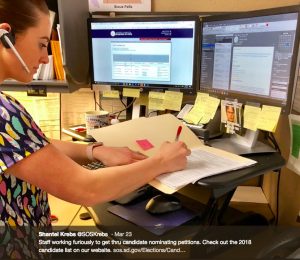
I filed two candidate petitions at the Secretary of State’s office in Pierre yesterday, one for Brooks Briscoe, one for myself. Secretary of State Shantel Krebs and her staff treated me with perfect courtesy (even though I could understand if our Republican election chief would feel the urge to slip me some bad Potato Olés). Deputy Secretary Kea Warne even ran copies of both petitions so Brooks and I could have copies with the official SOS “Received” date on them. On a busy day, the Secretary of State’s office handled my business professionally and helpfully, as Krebs’s team has on every occasion when I have brought them documents, challenges, or questions. We all should thank Secretary Krebs, Deputy Secretary Warne, and everyone else in our state election office for their good work.
Well, almost all of us.
As candidates enjoy same-day service, ballot question committees are left hanging for months. The Secretary of State’s turnaround time on ballot measures submitted in 2015 ran between two and three months. This cycle, Amendment W and Initiated Measure 24 got the green light in two months; Initiated Measure 25 took another six weeks. Almost four months passed after submission before SOS Krebs rejected the open-primary petition; the redistricting and voting-at-home petitions took another week or two after that. Sponsors of the prescription drug price cap and medical cannabis measures are still waiting for the Secretary’s go/no-go.
It’s not as if Secretary Krebs can’t turn petitions around quickly. Just yesterday, Krebs received and certified 41 Legislative petitions and Marty Jackley’s gubernatorial petition. Her staff checked maybe 2,100 signatures on the Legislative petitions (the SOS staff count and verify each signature line until they reach the minimum required) and another 673 on Jackley’s (Marty submitted 8,264 signatures; the new random-sampling table enacted last year only goes up to 5,000 signatures on candidate petitions, so the SOS had to do math yesterday and calculate that sample size! Kea gets danger pay!)
Now certainly statewide ballot question petitions are much bigger than candidate petitions. But once the sheets and lines are counted (a first-glance task requiring no research or reference to the voter database), the Secretary of State only checks random samples of signatures, around 700 to 720 signatures on a typical ballot question petition.
Yesterday showed that the Secretary of State’s office can fully process (not just count but check the validity of) over 2,700 signatures in one workday. At that clip, Secretary Krebs and her team could randomly sample three ballot question petitions and still have time to go downtown for tacos.
And remember that, in 2015, when state law locked the Secretary into a higher 5% sample on all ballot question petitions, the Secretary of State’s office was able to certify two referendum petitions in two days. When the Secretary has a deadline, she can meet it.
But while the deadline for submitting initiative petitions is one year before the general election, the Secretary’s practical deadline for certifying those petitions isn’t until maybe July 15 (30 days for petition challenges before the August 14 deadline to certify initiative and referendum language for the ballot). With no fire under her chair, Secretary Krebs can let initiative petitions sit on her desk, get pushed back by the rush of legislation in January, then get pushed back again by the candidate petition rush around the last Tuesday in March. And then the office could get wrapped up handling candidate petition challenges and printing the primary ballots in April….
This multi-month delay has a terrible impact on the ballot question committees. Since November 6, TakeItBack.org and New Approach South Dakota, the two committees with petitions still pending, have been unable to fully campaign for their issues. They can’t ask donors for money, they can’t reserve billboards or air time, and they can’t make seek commitments from staff or volunteers, since they don’t know yet if they’ll even have a ballot measure at which to throw money, ads, or campaigners.
Imagine what a petition-certification delay like this would do to a candidate. Imagine we made candidates submit their petitions a year before the election and then waited four months to check their signatures. That would be four months during which Marty and Kristi couldn’t really campaign and would have to focus… on… the full-time jobs we’ve already elected them to do.
Hmmm… maybe that part wouldn’t be so bad.
But we see here an intolerable double standard. Candidates get almost immediate certification of their petitions (and I’m glad they do, and I thank the Secretary and her staff for doing it and doing it well). Ballot question committees, which are forced by law to start campaigning much earlier than candidates, get left in limbo for months.
If we’re going to make ballot question committees wait until March or maybe April to know if they’ve qualified for the ballot, they should get to submit their petitions until March or April, just like candidates. Why make initiative committees hurry up and wait?
Swift petition turnaround keeps bureaucracy from hampering democracy. Secretary Krebs and her excellent team have shown they can turn petitions around fast for candidates and referendum campaigns; they can and should do the same for initiative campaigns.
Let us hope that picture of Mr. Dwight from the TV show was not printed on the taxpayer’s paper with taxpayer’s colored toner ink powder. That stuff is not cheap.